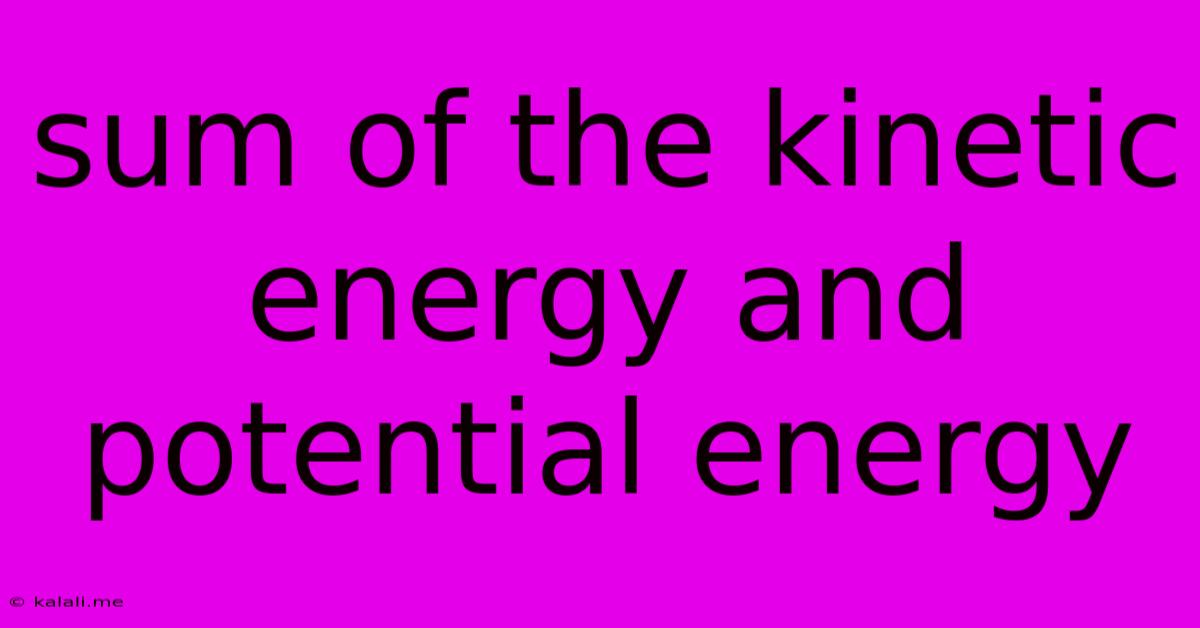Sum Of The Kinetic Energy And Potential Energy
Kalali
Jun 14, 2025 · 3 min read

Table of Contents
The Sum of Kinetic and Potential Energy: Understanding Mechanical Energy
Understanding the sum of kinetic and potential energy is crucial for comprehending fundamental concepts in physics, particularly mechanics. This article will explore the relationship between these two forms of energy, explain their individual roles, and delve into the principle of conservation of mechanical energy. This will help you grasp the core ideas and applications of this important physics principle.
What is Mechanical Energy?
Mechanical energy is the sum of the potential energy and kinetic energy in a system. It represents the total energy associated with the motion and position of objects within a system. This is different from other forms of energy like thermal energy or chemical energy. Understanding mechanical energy allows us to predict the behavior of objects in various scenarios, from a simple pendulum to complex planetary motion.
Kinetic Energy: Energy of Motion
Kinetic energy is the energy an object possesses due to its motion. A faster-moving object has more kinetic energy than a slower-moving object of the same mass. The formula for kinetic energy (KE) is:
KE = 1/2 * mv²
Where:
- m represents the mass of the object (in kilograms)
- v represents the velocity of the object (in meters per second)
The kinetic energy is always positive, as both mass and the square of velocity are always positive. Consider a rolling ball: the faster it rolls, the greater its kinetic energy. A stationary object has zero kinetic energy.
Potential Energy: Stored Energy
Potential energy is the energy stored within an object due to its position or configuration. Several types of potential energy exist, but the most commonly discussed is gravitational potential energy. This is the energy stored in an object due to its position relative to a gravitational field. The formula for gravitational potential energy (PE) is:
PE = mgh
Where:
- m represents the mass of the object (in kilograms)
- g represents the acceleration due to gravity (approximately 9.8 m/s² on Earth)
- h represents the height of the object above a reference point (in meters)
Other forms of potential energy include elastic potential energy (stored in a stretched spring) and chemical potential energy (stored in bonds between atoms). However, this article focuses primarily on gravitational potential energy for simplicity.
The Principle of Conservation of Mechanical Energy
In a closed system where only conservative forces (like gravity) are acting, the total mechanical energy remains constant. This means that the sum of kinetic and potential energy remains the same throughout the system's motion. Therefore:
Total Mechanical Energy (E) = KE + PE = Constant
This principle implies that as an object falls, its potential energy decreases, while its kinetic energy increases proportionally, maintaining a constant total mechanical energy. For example, a ball dropped from a height will convert its potential energy into kinetic energy as it falls. Ignoring air resistance, the total mechanical energy remains constant throughout its descent.
Examples and Applications
The concept of mechanical energy and its conservation is fundamental to many applications:
- Roller coasters: At the top of the hill, the roller coaster has maximum potential energy and minimum kinetic energy. As it descends, potential energy converts to kinetic energy, increasing speed.
- Pendulums: A pendulum swings back and forth, constantly exchanging potential and kinetic energy. At the highest point, potential energy is maximum, and at the lowest point, kinetic energy is maximum.
- Projectile motion: The total mechanical energy of a projectile (ignoring air resistance) remains constant throughout its trajectory.
Conclusion
Understanding the relationship between kinetic and potential energy, and the principle of conservation of mechanical energy, provides a powerful framework for analyzing motion and energy transformations in numerous physical systems. By mastering these concepts, you unlock a deeper understanding of the physical world around us.
Latest Posts
Latest Posts
-
What Are The Prime Factors Of 62
Jun 15, 2025
-
Does University Of Tampa Require Sat
Jun 15, 2025
-
What Important Topic Is Discussed In This Passage
Jun 15, 2025
-
Example Of Foreclosure Letter From Bank
Jun 15, 2025
-
What Is The Factors Of 44
Jun 15, 2025
Related Post
Thank you for visiting our website which covers about Sum Of The Kinetic Energy And Potential Energy . We hope the information provided has been useful to you. Feel free to contact us if you have any questions or need further assistance. See you next time and don't miss to bookmark.